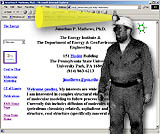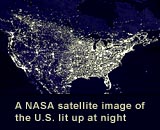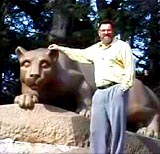 Home
Home

We are ubiquitous users of energy both in the home and at work, and readily available energy contributes significantly to the high standard of living that we all expect. Of course, there are costs associated with this kind of energy use, not the least of which are the environmental costs, or as some might say, the environmental "challenges." We have come to expect to have unhindered energy use, while at the same time expecting our streams to be clear, our skies to be blue, and our air to be crisp and clean.
The primary purpose of this course is to provide students with an engaging, personalized, relevant, and in depth look at the ways in which our energy use and our environment are interconnected. Through a student-centered approach, the materials, resources, and interactions in EGEE 101 are designed and structured around students - their personal roles and experiences as energy consumers, as environmental stewards, and as increasingly informed, productive, responsible, and active citizens of the world.
Topics will range from the more personal issues of individual energy use, electrical demand, home heating, natural gas, and transportation, to nationally and internationally significant issues such as "global warming", "acid rain", smog, ozone hole(s), pollution control, conservation, and security. Students will leave this course with a broad understanding of energy in its many forms and a greater awareness of the interrelationships between man, nature, and the systemic relationship between energy and the environmnet. As such, EGEE will meet the goals established for the Natural Sciences General Education knowledge domain (GN)
The use of the World Wide Web permits us to teach beyond the traditional borders of the classroom, and to a wider and more diverse audience. As there are no preset meeting times this class will serve those who are struggling with scheduling issues, working students, adult learners, or perhaps students away at home for the summer who wish to pick up 3 credits. The approach of this class is to make the complete learning experience, via PSU's ANGEL system, available to students 24 hours a day, 7 days a week. A combination of text, images, animations, audio files, simulations, digital video clips and class contact through online communications are the basis of information transfer and mastery. Online quizzes are used to provide immediate, answer specific feedback and to promote learning of the material. Mastery of material will be evident from team projects and class communications.

EGEE 101 is designed to serve the non-scientist. There are no specific course prerequisites, and students with math and science phobias are encouraged to enroll in this class. Students in this course will encounter math and science only when they help provide clarification for information and issues pertaining to energy and environment, and course grading will not be based on students' ability to recall, remember, and apply mathematical and scientific facts and principles.
Diversity is an asset to this course, and a class that includes students from as many colleges, semester standings, and Penn State campuses as possible will enhance the course immensely. Opportunities for communication and discourse are a high priority in EGEE 101, and a variety of opinion, experience, and perspective will enrich the experience significantly. Energy and the Environment 101 opens its doors to a worldwide audience via Penn State's World Campus in the Spring of 2003, likely resulting in further diversification of the course demographics.
Like other GenEd courses offered through the e-Education Institute, EGEE 101's success will be measured primarily by students' satisfaction with the course experience, by their level of participation in the online learning community, and by their mastery of the course material. Underlying this approach is a working hypothesis that will be the target of our varied assessment strategies: That student engagement--defined as a quantity and quality of time spent in learning tasks and activities--directly results in student satisfaction, participation, and performance, and consequently is the single-best indicator of student success and satisfaction in (online?) academic course work.

Student satisfaction with the course will be measured via the use of Penn State's Standard SRTE's (Student Rating of Teaching Effectiveness) along with short surveys embedded within course lessons. Together, these instruments will enable students to reflect upon their experiences in both incremental and holistic fashion. Higher ratings will likely indicate that students' online experiences in EGEE 101 were at least as satisfying as their resident classes.
Students' participation and progress will be evaluated through a combination of low-stakes quizzes, a number of individual and team-based exercises, reports, and projects, and one or two comprehensive assessments, either exams or papers. Additionally, student's participation in discussions, debates, and other communications activities will help them strengthen their grasp on the material while at the same time giving the instructor a dynamic view of students' perspectives and thinking. Instructors will utilize the extensive tools and features of ANGEL and Test Pilot to monitor, collect, manage, and evaluate the information relating to students' activities interactions, time on task, and use of instructional resources.
Energy and The Environment will be conducted entirely on the World Wide Web, except for proctored final exams and office hours during which instructors will be available online or by telephone. There will be no set class meeting times, but students will be required to complete weekly assignments. The course consists of four components: Lessons, Discussions, Projects, and examinations. Lesson modules consist of:
This sample lesson from Energy and The Environment 101, Lesson 10: "Climate Change", deals with some of the most recognizeable issues surrounding energy use and environmental consequences; Global warming, pollution, etc. You will need three plug-ins to view the media in these lessons: Flash 5.0+, Shockwave 8.0+, and Quicktime 5.0+. Also, be aware that some of the media is large (especially video and QuicktimeVR) and may take time to load on a slow connection such as a modem. For students enrolled in the course, a CD is available for delivery of large media files.
Dr. Mathews and his team of teaching assistants will monitor the course site daily to determine the extent to which students are staying on schedule, completing assignments, and participating in the the regularly scheduled online discussions which make up a significant part of the course activity. This daily activity will also allow the course to be dynamically adjusted to the changing perspectives and needs of the students. Course exercises and projects will require students to apply skills and knowledge they acquire in the course to new situations. Lesson quizzes will be used to enhance and reinforce learning through the use of instant contextual feedback, and regular communications exercises will facilitate the development of a learning community in which students exchange information and ideas, and share their observations, opinions, experiences, and coursework.

A typical week for an online student will consist of online readings and materials, web site explorations, and interactive activities all packaged into weekly lessons complete with digital videos, audio explanations, animations, and small simulations. Online games and quizzes with immediate feedback will be used to extend and reinforce the material and provide additional learning opportunities for students, and small team-based projects and communication exercises will take place roughly every other week, giving students opportunities to work and collaborate with their peers within small groups. Finally, teams will be arranged into small learning communities of approximately 20 students, providing a larger, but comfortably sized virtual forum for student discussions, debates, questions, explanations, and other forms of exchange and communications. The dynamic nature of this course and its emphasis on interaction practically guarantees that no two weeks will ever be alike.